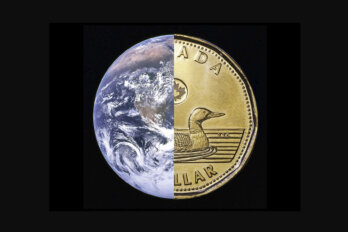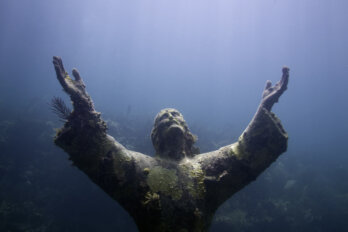I don’t eat fish. And before I explain why, let me state upfront that I’m not aiming to shame fish eaters. I’m not an activist or an alarmist. I’m an early-career fish biologist—specifically, a physiologist who studies the impacts of environmental stressors on fish energetics and behaviour.
My fieldwork has taken me to the Caribbean, to oil-contaminated rivers in Trinidad, to small lakes in Uganda, and to the Great Lakes. I spend most of my days in a laboratory in Montreal, measuring swimming and metabolic performance in African fish species, and catching up on the latest studies in marine and freshwater biology. Many of my friends work in related fields, such as fisheries management, hydropower, and pollution and sustainability in aquatic systems. Over the past nine years, I’ve seen, read, and heard about what happens to fish before it ends up on our plates. And now, whenever my friends order sushi takeout, or my dad enjoys his breaded fish fillets, or even when my cat eats his “seafood medley” dinner, I get nervous—not just for the fish, but also for my loved ones.
Several well-publicized studies have shown that the fillets served up on restaurant plates often don’t match what’s listed on the menus. Oceana, a United States–based environmental advocacy group, recently compiled the findings of 200 studies and determined that out of 25,700 seafood samples from fifty-five countries, one-fifth were mislabelled—for instance, in many cases, the salmon labeled as “wild-caught” was in fact farmed. A Canadian study in 2011 showed that in a sample of more than 200 seafood items obtained from various fish retailers and restaurants in cities including Toronto, Montreal, and Vancouver, 41 percent were misidentified. In some cases, what we’re paying for isn’t even seafood: a study sampling caviar from Romania and Bulgaria found that more than 10 percent of samples contained no animal DNA at all.
You might even be eating fish you didn’t know you had a sensitivity to. For example, escolar, often called “white tuna” on sushi menus, is a snake mackerel that’s routinely substituted for many different fish. While escolar’s oily texture is appealing to some taste buds, it can also be indigestible, causing severe diarrhea and cramping.
I’d much rather put a stop to mislabelling practices than boycott fish. The problem is, it’s hard to pinpoint the culprits. The studies I’ve read usually avoid identifying who’s behind the practice of mislabelling, and the uncertainty that creates harms the reputation of everyone else along the distribution chain—including fishermen who play by the rules and make the effort to correctly identify their catch. Mislabelling itself isn’t always straightforwardly illegal. According to current Canadian Food Inspection Agency (CFIA) guidelines, for example, the general term “rockfish” can be used as a label on more than 100 different species in grocery stores and restaurants, even though some of the species are endangered or at risk. Ocean advocacy groups such as SeaChoice—which recently gave Canada a failing grade for its seafood-labelling practices—have been urging the CFIA to require more details on labels, including the scientific name of the species. The CFIA has responded to SeaChoice’s report by saying its proposals for modernizing Canada’s food-labelling practices are in line with the group’s recommendations. But even if labelling practices changed drastically in the near future, I would still avoid seafood.
Let’s say you buy your seafood from a store that correctly labels its fish, or from a fisherman you trust. Maybe you even catch it yourself. But no matter how careful you are, if you eat seafood fairly regularly, chances are you’ve ingested plastic. Much of what we throw away ends up in the world’s water systems: recent studies estimate there are over five trillion pieces of plastic—weighing 244 million kilograms—currently floating in the world’s oceans, and that number is expected to grow. Yet it’s impossible to precisely quantify just how much plastic litters our oceans, or even to locate it all. The Great Pacific Garbage Patch, essentially a vortex where most of the waste discarded in the Pacific Ocean ends up, is usually depicted in photos as a stable floating island of trash. Much of the plastic debris there, though, is actually an aggregation of tiny particles known as microplastics, which are shed by larger pieces of plastic over time. The water surrounding the Great Pacific Garbage Patch is cloudy with microplastics, and loose chunks of larger debris float near the island or sink below the surface to form underwater garbage mounds. And unlike the patch—a single, giant, identifiable entity—microplastics are everywhere.
Plastic pollution is so rampant, and our waterways and bodies so interconnected, that I question whether any aquatic environments can truly be called pristine. At less than five millimetres long, many microplastics are difficult or impossible to spot with the naked eye, and they can permeate and persist in sea ice, shorelines, surface waters, estuaries, and marine sediments. I spend a significant amount of my time working on and under the water, and I can’t remember the last time I didn’t see some kind of plastic debris floating on the surface or stuck amongst corals or rocks. My diving gear once got entangled in a discarded six-pack ring. While building sandcastles on a Caribbean beach with my students, I had to pull little plastic pieces out of every handful of sand. Almost every marina that I’ve worked out of has had its fair share of debris—usually discarded gear, plastic utensils, and cups—under the docks or along the shore. Most of the plastic ever produced is still on Earth in some shape or form, and some of it is ending up in our food.
As much as I love fish, I can’t pretend that they’re wise animals with refined palates. Researchers have found that when given the choice between natural and microplastic food items, fish tend to choose the plastic. For most aquatic animals, finding food while avoiding predators is a struggle, so being picky or discerning is not evolutionarily beneficial; most species grab their desired snack quickly and head right back to their hiding place. As a result, aquatic animals often ingest floating bits of plastic, either by confusing colourful microplastics for something else, or by ingesting plastic-contaminated prey. Filter-feeding animals such as clams, oysters, and mussels obtain their nutrients by sucking in water, trapping small floating particles within in it, and then spitting the water back out. Mussels are so efficient at this process that they’ve been used to clear up polluted waterways. Unfortunately, much of what they trap these days is plastic: a recent study estimated that the average European could ingest about 11,000 microplastics per year just by including mussels and oysters in their diet.
Due to bioaccumulation (when a substance’s concentration increases in an animal over time) and biomagnification (when a substance’s concentration increases as it moves up the food chain), the concentration of microplastics in larger, older, and predatory fish such as tuna is likely to be higher than in smaller species or younger individuals. So what happens to other top predators—humans—who eat a seafood-rich diet during their lifetime? Even though current research shows we do not absorb most plastics, it’s possible that a small amount (about 1 percent) can still accumulate in our bodies over time.
That number might change: research on microplastics in our food is still in its infancy, and while some studies have documented the detrimental effects of plastics on fish and other aquatic animals, we still don’t know much about their long-term effects on humans.
I recognize that I’m lucky enough to be able to choose not to eat seafood. Most grocery stores near my home and office in Montreal offer a range of protein options, including meats—which, I realize, come with their own host of ethical and environmental issues—as well as beans, tofu, dairy products, and protein bars and shakes. But my fieldwork has also taken me to places such as Nabugabo, a Ugandan village bordering a small lake, where locals’ primary source of consistent protein is fish. There are countless locations like this around the world, many of which are also severely polluted as a result of inadequate waste management systems. Are those who live there doomed to continue eating fish that might well be contaminated with a substance we still don’t really understand? Even if they manage to control their pollution levels, will the waste produced elsewhere in the world contaminate their food sources regardless?
There are steps we can take on the community level to make seafood safer. We can demand stricter and more specific labelling guidelines from federal food agencies and fish distributors. Plastic pollution in our oceans and lakes is an immense problem: scientists have estimated that by 2050 there will be more plastic by weight in the ocean than fish. We don’t yet know how to filter out all that plastic responsibly; the only ways to mitigate the problem are to reduce our reliance on single-use items—do you really need a straw to drink your ice water?—and avoid products wrapped in excessive packaging. Zero-waste grocery stores are popping up across Canada, and even regular stores will sometimes allow you to bring your own containers if you ask for fresh items, such as cheese, meats, and salads. In 2018, Canada will join the list of countries that ban microbeads, small bits of plastic often found in cosmetic products and detergents.
Since fish can’t be picky about their food, maybe we just need to be pickier about ours. Recently, I watched a diner closely question a waiter about the cream content of the tartar sauce that came with her fish and chips, but not about the actual identity of the menu-listed “whitefish”—a term used to describe any number of fish species. Watching their exchange, I wondered whether restaurant menus need new symbols along the lines of the ones that identify gluten-free, dairy-free, and vegan items—symbols that declare fish to be “species verified” or “plastic free.” If consumers were more aware of what was in their fish—and what type of fish they were eating in the first place—they might be able to hold key players in the fish industry accountable. And who knows: at that point, I just might consider eating fish again.




